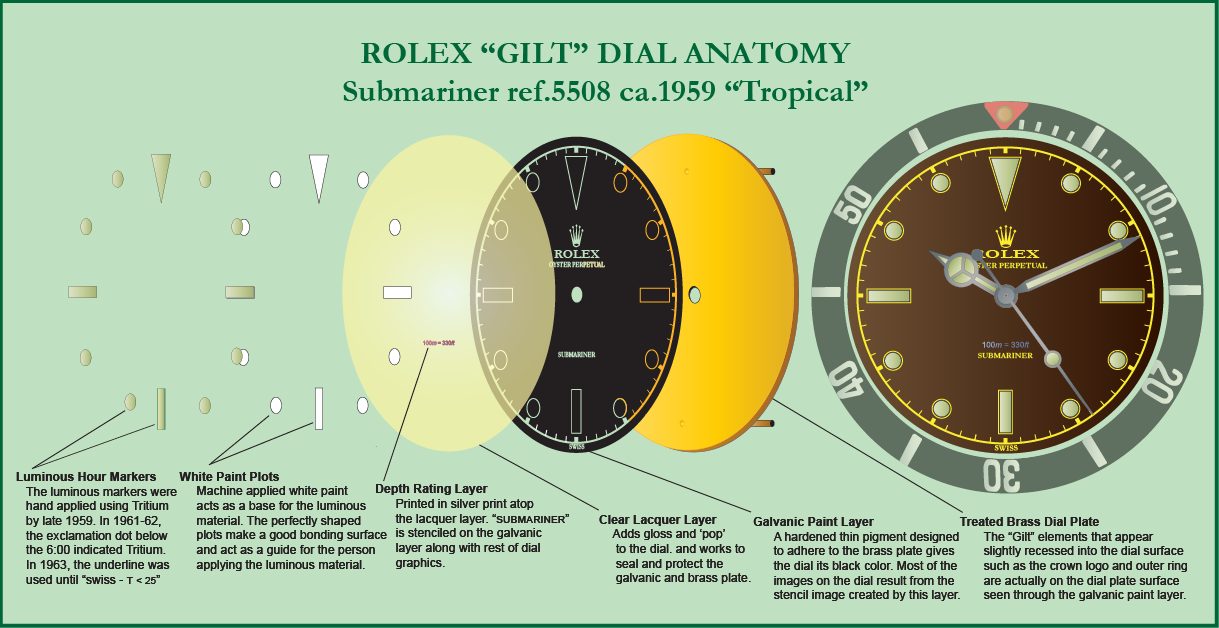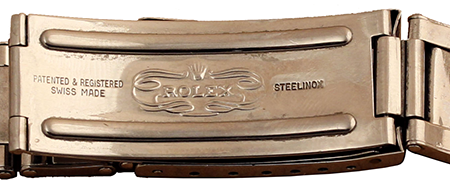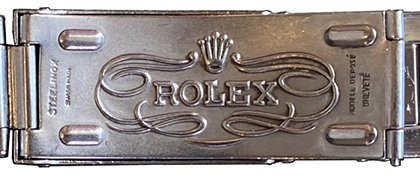Case No. 489,967
At first glance, it appears these are pictures of two different watches, but it is actually the same watch in different lighting. It exemplifies one of the more striking characteristics particular to "Tropical" dials, also known as "Color Change" dials. A Tropical dial can appear to change color or have a different appearance depending on the light source and its viewing angle.

The luminous material on the dial and hands was manually applied Tritium. The glow that emanates from the Tritium material on the dial and hands is even and relatively bright when exposed to UV light. It is in stark contrast compared to the faint speckled glow that comes from Radium. The Tritium also has a relatively low Geiger reading. Please see Luminous Material section for more examples and detailed information.
The hands are made with steel that is chrome plated, similar to the above example. However, due to oxidation, the mounted hands have developed a matte finish and appear to be covered with a light coating of rust. The resulting effect can be misleading, as they appear to match the gold lettering of the dial intentionally. The hands are flat on top, a design that came to be known by collectors as "Gilt Hands." When the hands move about the face of the dial, the sweep-seconds hand appears to lightly graze the "Chapter" ring of the minute track. When it briefly glides over the minute hand, they are perfectly aligned.
The lettering and graphics on this Submariner 5508 from 1959 has the same characteristics as the preceding Submariner 6536-1 from the same year. Both have a silver depth rating and a 6:00 marker that is the same color as the rest of the dial. The hour and minute hands are also finished in chrome but on this Submariner 5508, the sweep seconds hand is not painted white. However, there is a very important key difference that can be easily overlooked between the two models. The luminous material on the Submariner 5508 is Tritium while the Submariner 6536-1 is Radium. The hands and hour markers don't have the orange ochre color of Radium, they are more yellow with a greenish tinge. Unlike Radium, the glow of these Tritium markers under UV light is very strong and lasts a short time after the light source is removed.
Although the materials and manufacturing process was identical for normal black dials, in some rare instances, the black galvanic layer would some of its pigment. This loss of opacity allows the underlying brass plate to show through, resulting in a shift to a brown color. This phenomena is unique in each instance and therefore no two Tropical dials are exactly the same.
Although theories abound, the cause and length of time it takes for a Tropical dial to develop are still largely a mystery. It is strongly suspected that humidity contributes to the effect because a significant number of watches with Color Change dials have originated from tropical parts of the world. The intensity of the color change can range a wide gamut. Some dials have a slight color change and need to be in direct sunlight for the effect to be noticeable, while others, with more profound color shifts, have a visible brown tone even without direct light. The condition of Tropical dials also varies greatly. Some are perfectly preserved with full gloss and no deterioration of the luminous material, while others have changed color from water damage. Only a precious few of these dials survive because they were all considered defective and routinely replaced by Rolex and watchmakers during service. As a result, well preserved specimens are extremely rare and valuable.
The outer case back is flat and reference number 5508 is stamped inside the case back with a date code. Although the case back date of "III. 58" appears to show the year of manufacture of this Submariner 5508 is 1958, however the serial range indicates that it was produced in 1959. Please visit the section on Rolex Date Codes for more information. The Submariner 5508 is powered by the Rolex 1530 Automatic movement. The Submariner 5508 also uses the #16 crystal that fits the Submariner 6536-1.




In 1959, two distinct clasp designs were being commissioned by Rolex from bracelet maker Gay Frères. The Small Logo, which became the standard clasp for the Swiss Rivet bracelets until 1969 and the Big Logo which is coveted by collectors but was only produced until 1960. Additional details about end links and bracelets can be found here.
Small Logo clasp introduced in 1958
Big Logo clasp introduced in 1958
Rolex also contracted with C&I to make bracelets in the United States. The import duties on Swiss made bracelets was becoming cost prohibitive and it made more economic sense to have a US based manufacturer. C&I produced Hollow Rivet bracelets with unmarked end links that have a markedly lighter gauge than Swiss made bracelets. Additional details about end links and bracelets can be found here.
US Made C&I Rivet Bracelet 1958
RolexHaven.com is intended for informational purposes only and is in no way sponsored, endorsed,
or affiliated with Rolex U.S.A., Rolex S.A. or any other Rolex worldwide subsidiary. © All Rights Reserved 2020